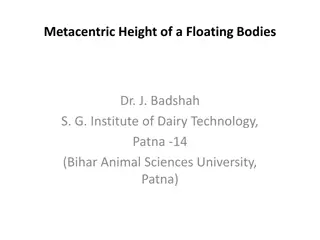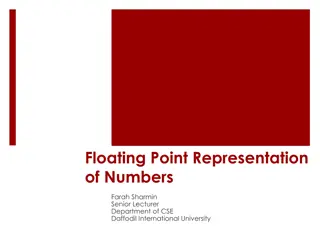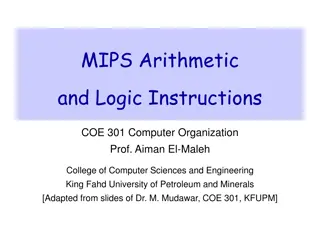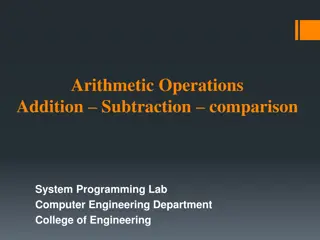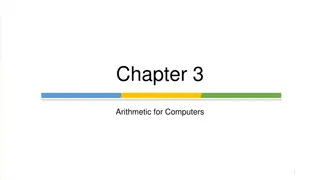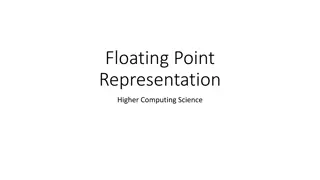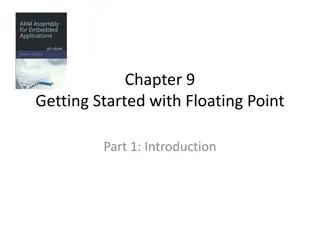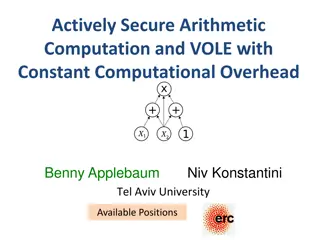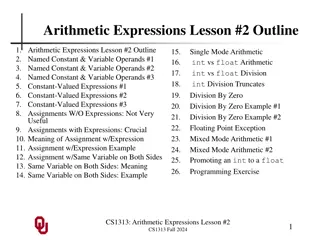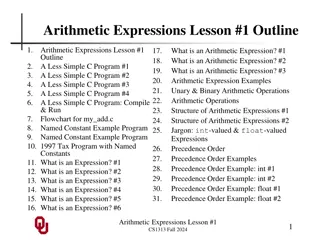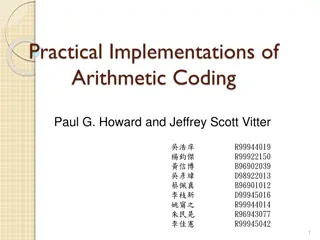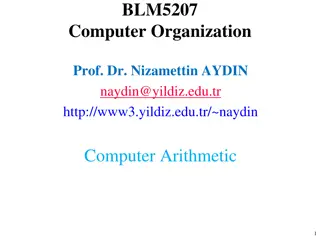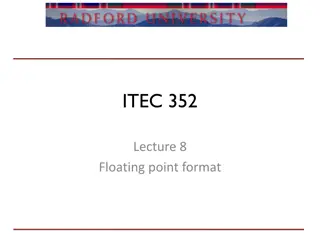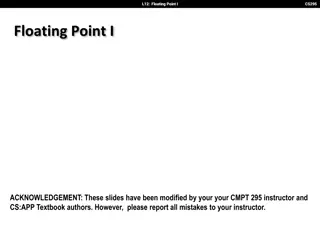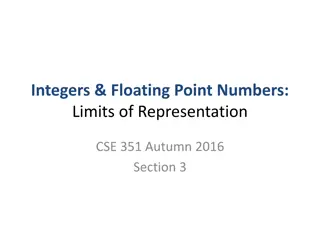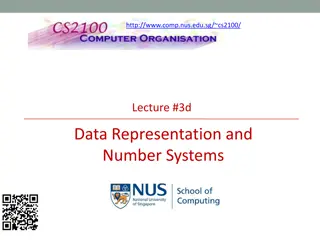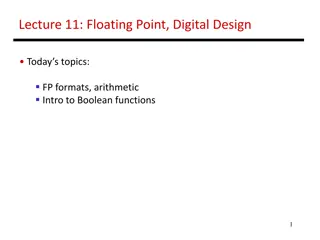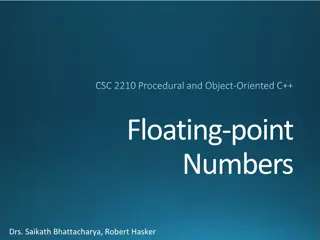Division and Floating Point Arithmetic
Explore the concepts of division and IEEE 754 representations in floating point arithmetic. Learn about the processes involved in division, including steps to find quotient and remainder. Delve into an example of dividing numbers along with hardware implementation for efficient division.
Download Presentation

Please find below an Image/Link to download the presentation.
The content on the website is provided AS IS for your information and personal use only. It may not be sold, licensed, or shared on other websites without obtaining consent from the author.If you encounter any issues during the download, it is possible that the publisher has removed the file from their server.
You are allowed to download the files provided on this website for personal or commercial use, subject to the condition that they are used lawfully. All files are the property of their respective owners.
The content on the website is provided AS IS for your information and personal use only. It may not be sold, licensed, or shared on other websites without obtaining consent from the author.
E N D
Presentation Transcript
Lecture 10: Division, Floating Point Today s topics: Division IEEE 754 representations 1
Division 1001ten Quotient Divisor 1000ten | 1001010ten Dividend -1000 10 101 1010 -1000 10ten Remainder At every step, shift divisor right and compare it with current dividend if divisor is larger, shift 0 as the next bit of the quotient if divisor is smaller, subtract to get new dividend and shift 1 as the next bit of the quotient 2
Division 1001ten Quotient Divisor 1000ten | 1001010ten Dividend 0001001010 0001001010 0000001010 0000001010 100000000000 0001000000 0000100000 0000001000 Quo: 0 000001 0000010 000001001 At every step, shift divisor right and compare it with current dividend if divisor is larger, shift 0 as the next bit of the quotient if divisor is smaller, subtract to get new dividend and shift 1 as the next bit of the quotient 3
Divide Example Divide 7ten (0000 0111two) by 2ten (0010two) Iter 0 1 Step Quot Divisor Remainder Initial values 2 3 4 5 4
Divide Example Divide 7ten (0000 0111two) by 2ten (0010two) Iter 0 1 Step Quot 0000 0000 0000 0000 0000 0000 0000 0000 0000 0001 0001 0011 Divisor 0010 0000 0010 0000 0010 0000 0001 0000 0001 0000 0001 0000 0000 1000 0000 0100 0000 0100 0000 0100 0000 0010 0000 0001 Remainder 0000 0111 1110 0111 0000 0111 0000 0111 1111 0111 0000 0111 0000 0111 0000 0111 0000 0011 0000 0011 0000 0011 0000 0001 Initial values Rem = Rem Div Rem < 0 +Div, shift 0 into Q Shift Div right Same steps as 1 2 3 4 Same steps as 1 Rem = Rem Div Rem >= 0 shift 1 into Q Shift Div right Same steps as 4 5 5
Hardware for Division Source: H&P textbook A comparison requires a subtract; the sign of the result is examined; if the result is negative, the divisor must be added back Similar to multiply, results are placed in Hi (remainder) and Lo (quotient) 6
Efficient Division 7 Source: H&P textbook
Divisions involving Negatives Simplest solution: convert to positive and adjust sign later Note that multiple solutions exist for the equation: Dividend = Quotient x Divisor + Remainder +7 div +2 Quo = Rem = -7 div +2 Quo = Rem = +7 div -2 Quo = Rem = -7 div -2 Quo = Rem = 8
Divisions involving Negatives Simplest solution: convert to positive and adjust sign later Note that multiple solutions exist for the equation: Dividend = Quotient x Divisor + Remainder +7 div +2 Quo = +3 Rem = +1 -7 div +2 Quo = -3 Rem = -1 +7 div -2 Quo = -3 Rem = +1 -7 div -2 Quo = +3 Rem = -1 Convention: Dividend and remainder have the same sign Quotient is negative if signs disagree These rules fulfil the equation above 9
Floating Point Normalized scientific notation: single non-zero digit to the left of the decimal (binary) point example: 3.5 x 109 1.010001 x 2-5two = (1 + 0 x 2-1 + 1 x 2-2+ + 1 x 2-6) x 2-5ten A standard notation enables easy exchange of data between machines and simplifies hardware algorithms the IEEE 754 standard defines how floating point numbers are represented 10
Sign and Magnitude Representation Sign Exponent Fraction 1 bit 8 bits 23 bits S E F More exponent bits wider range of numbers (not necessarily more numbers recall there are infinite real numbers) More fraction bits higher precision Register value = (-1)S x F x 2E Since we are only representing normalized numbers, we are guaranteed that the number is of the form 1.xxxx.. Hence, in IEEE 754 standard, the 1 is implicit Register value = (-1)S x (1 + F) x 2E 11
Sign and Magnitude Representation Sign Exponent Fraction 1 bit 8 bits 23 bits S E F Largest number that can be represented: Smallest number that can be represented: 12
Sign and Magnitude Representation Sign Exponent Fraction 1 bit 8 bits 23 bits S E F Largest number that can be represented: 2.0 x 2128 = 2.0 x 1038 Smallest number that can be represented: 1.0 x 2-127 = 2.0 x 10-38 Overflow: when representing a number larger than the one above; Underflow: when representing a number smaller than the one above Double precision format: occupies two 32-bit registers: Largest: Smallest: Sign Exponent Fraction 1 bit 11 bits 52 bits S E F 13
Details The number 0 has a special code so that the implicit 1 does not get added: the code is all 0s (it may seem that this takes up the representation for 1.0, but given how the exponent is represented, that s not the case) (see discussion of denorms (pg. 222) in the textbook) The largest exponent value (with zero fraction) represents +/- infinity The largest exponent value (with non-zero fraction) represents NaN (not a number) for the result of 0/0 or (infinity minus infinity) Note that these choices impact the smallest and largest numbers that can be represented 14
Exponent Representation To simplify sort, sign was placed as the first bit For a similar reason, the representation of the exponent is also modified: in order to use integer compares, it would be preferable to have the smallest exponent as 00 0 and the largest exponent as 11 1 This is the biased notation, where a bias is subtracted from the exponent field to yield the true exponent IEEE 754 single-precision uses a bias of 127 (since the exponent must have values between -127 and 128) double precision uses a bias of 1023 Final representation: (-1)S x (1 + Fraction) x 2(Exponent Bias) 15
Examples Final representation: (-1)S x (1 + Fraction) x 2(Exponent Bias) Represent -0.75ten in single and double-precision formats Single: (1 + 8 + 23) Double: (1 + 11 + 52) What decimal number is represented by the following single-precision number? 1 1000 0001 01000 0000 16
Examples Final representation: (-1)S x (1 + Fraction) x 2(Exponent Bias) Represent -0.75ten in single and double-precision formats Single: (1 + 8 + 23) 1 0111 1110 1000 000 Double: (1 + 11 + 52) 1 0111 1111 110 1000 000 What decimal number is represented by the following single-precision number? 1 1000 0001 01000 0000 -5.0 17
FP Addition Consider the following decimal example (can maintain only 4 decimal digits and 2 exponent digits) 9.999 x 101 + 1.610 x 10-1 Convert to the larger exponent: 9.999 x 101 + 0.016 x 101 Add 10.015 x 101 Normalize 1.0015 x 102 Check for overflow/underflow Round 1.002 x 102 Re-normalize 18
FP Addition Consider the following decimal example (can maintain only 4 decimal digits and 2 exponent digits) 9.999 x 101 + 1.610 x 10-1 Convert to the larger exponent: 9.999 x 101 + 0.016 x 101 Add 10.015 x 101 Normalize 1.0015 x 102 Check for overflow/underflow Round 1.002 x 102 Re-normalize If we had more fraction bits, these errors would be minimized 19






